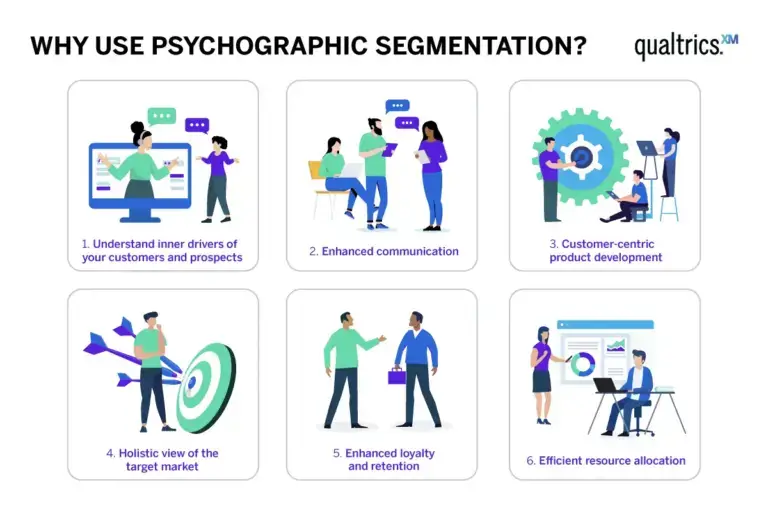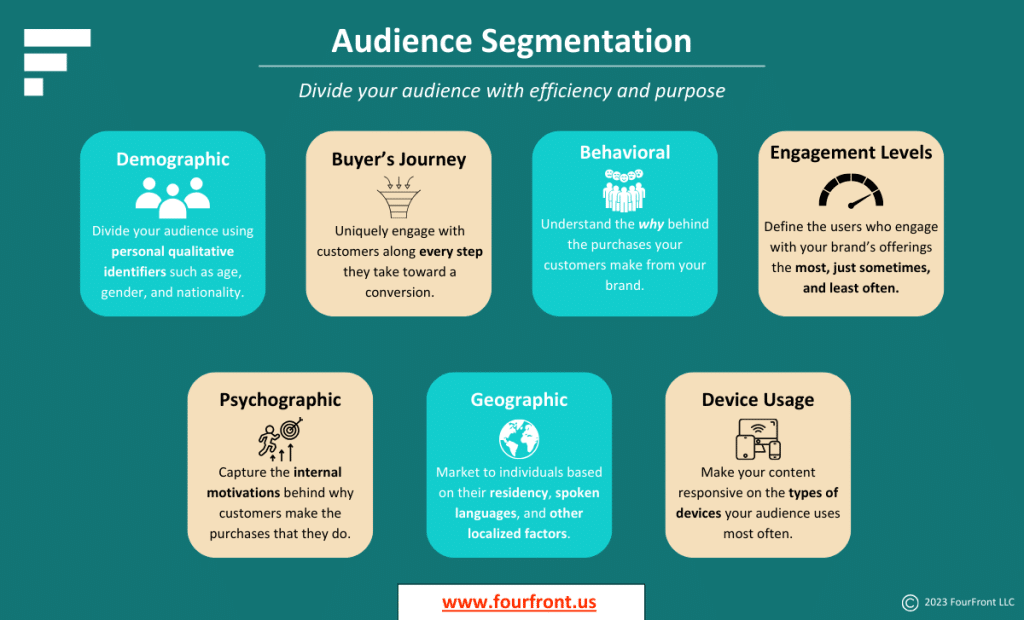Uncover the secrets of psychographic segmentation and learn how to tap into your audience’s mindset for maximum engagement.

Image courtesy of via DALL-E 3
Table of Contents
- Introduction to Psychographic Segmentation
- Understanding Psychological Traits
- Methods to Collect Psychographic Data
- Creating Psychographic Profiles
- Case Studies of Psychographic Segmentation
- Benefits and Challenges of Psychographic Segmentation
- Tips for Implementing Psychographic Segmentation
- Conclusion: The Power of Knowing Your Audience
- Frequently Asked Questions (FAQs)
Introduction to Psychographic Segmentation
Psychographic segmentation is a crucial aspect of understanding your audience’s mindset to create effective marketing strategies. By delving into the psychological aspects that drive consumer behavior, businesses can tailor their messages and products to resonate with their target customers. In this section, we will explore what psychographic segmentation is, why it matters in marketing, and how it helps businesses connect with the right audience.
What is Psychographic Segmentation?
Psychographic segmentation can be thought of as grouping people based on their psychological traits, such as personalities, values, interests, and lifestyles. It goes beyond basic demographics like age and gender to understand the underlying motivations and preferences of consumers. By knowing these psychological traits, businesses can create targeted marketing campaigns that speak directly to the desires and aspirations of their audience.
Why Does It Matter?
Psychographic segmentation is essential in marketing because it helps businesses reach the right audience with the right message. Understanding the mindset of your customers allows you to tailor your products and services to meet their specific needs and preferences. By connecting on a deeper level with your audience, you can build stronger relationships, increase brand loyalty, and drive sales. In short, psychographic segmentation is the key to unlocking the full potential of your marketing strategy.
Understanding Psychological Traits
Have you ever noticed that some people are outgoing and adventurous, while others are more shy and prefer to stay home? These differences in behavior are part of their personality traits. Personality traits are the unique characteristics that make each person who they are. For example, a person who is creative and spontaneous may be more likely to try new products or experiences, while someone who is practical and organized may prefer to stick with familiar choices.
Values and Beliefs
Values and beliefs play a significant role in how people make decisions. Values are the core principles that guide a person’s behavior, while beliefs are the convictions they hold about various aspects of life. For instance, someone who values sustainability may choose eco-friendly products, while a person who believes in honesty might be more loyal to brands that promote transparency.
Interests and Hobbies
Interests and hobbies reflect the things people enjoy doing in their free time. These can influence the way individuals make choices about products or services. For example, someone who loves cooking might be drawn to kitchen gadgets, while a person who enjoys sports may be interested in athletic gear. Understanding your audience’s interests can help tailor your marketing to appeal to their passions.
Lifestyles
Lifestyles encompass the way people live their lives, including their habits, routines, and social behaviors. Different lifestyles can impact consumer decisions significantly. For instance, a person with a busy, on-the-go lifestyle may prioritize convenience and speed when choosing products or services. By identifying and understanding the lifestyles of your audience, you can tailor your marketing strategies to meet their specific needs and preferences.
Methods to Collect Psychographic Data
When it comes to understanding your audience’s mindset through psychographic segmentation, collecting data is key. There are various methods you can use to gather valuable insights into the psychological traits of your target market. Here are some effective ways to collect psychographic data:

Image courtesy of www.qualtrics.com via Google Images
Surveys
Surveys are a great tool for collecting psychographic data as they allow you to directly ask your audience about their preferences, interests, and behaviors. By designing targeted surveys with questions related to personality traits, values, hobbies, and lifestyles, you can gain valuable insights into your audience’s mindset.
Focus Groups
Focus groups involve bringing together a small group of people to discuss and provide feedback on a particular topic. By conducting focus groups focused on psychographic traits, you can observe how individuals interact, express their opinions, and uncover deeper insights into their mindset and behaviors.
Social Media Analysis
Social media platforms are a treasure trove of psychographic data. By analyzing social media interactions, likes, shares, and comments, you can gain valuable insights into your audience’s interests, values, and preferences. Social media analysis tools can help you track trends and patterns to better understand your target market.
Online Behavior Tracking
Tracking online behavior, such as website visits, clicks, and online purchases, can also provide valuable psychographic insights. By analyzing how your audience interacts with your online content and products, you can infer their personality traits, values, and interests. This data can help you tailor your marketing strategies to better resonate with your target audience.
Creating Psychographic Profiles
In order to effectively target the right audience for your marketing strategies, it’s essential to create psychographic profiles. These profiles help you understand the mindset of your audience and tailor your messages to appeal to their specific traits and behaviors.
Combining Data
When creating psychographic profiles, it’s crucial to merge different types of psychographic data to form a comprehensive view of your audience. This includes information on personality traits, values, interests, hobbies, and lifestyles. By combining these factors, you can paint a detailed picture of who your audience is and what motivates their decisions.
Identifying Common Traits
After gathering psychographic data, the next step is to identify common traits among your audience. Look for patterns and similarities in their values, beliefs, and behaviors. By pinpointing these shared characteristics, you can segment your audience into meaningful groups that allow for more targeted marketing strategies.
Using Profiles in Marketing
Once you have created psychographic profiles and segmented your audience, it’s time to put these insights to use in your marketing efforts. Tailor your messages and campaigns to resonate with each segment’s unique characteristics. By speaking directly to their interests and preferences, you can increase the effectiveness of your marketing and connect with your audience on a deeper level.
Case Studies of Psychographic Segmentation
Let’s dive into a real-life example of how Company A effectively utilized psychographic segmentation to understand their audience better. By examining the values, beliefs, and interests of their customers, Company A was able to tailor their marketing messages to resonate with specific segments of their audience. For instance, they discovered that one segment valued sustainability and eco-friendly products, so they launched a marketing campaign highlighting their environmentally friendly practices. As a result, this segment became loyal customers, driving sales and brand loyalty for Company A.

Image courtesy of xperiencify.com via Google Images
Case Study 2: Company B
In another case study, Company B successfully implemented psychographic segmentation to reach their target audience more effectively. Through analyzing the lifestyles and hobbies of their customers, Company B identified a segment of adventure enthusiasts who were passionate about outdoor activities. By creating targeted marketing campaigns that spoke to this adventurous spirit, Company B saw a significant increase in engagement and sales within this specific segment. This personalized approach not only boosted customer satisfaction but also strengthened the brand’s image in the eyes of their audience.
Benefits and Challenges of Psychographic Segmentation
Psychographic segmentation offers many benefits in helping businesses understand and target their audiences effectively. By delving into the psychological traits of consumers, companies can tailor their marketing strategies to resonate with specific audience segments, leading to higher engagement and conversion rates. Here are some key advantages of using psychographic segmentation:
1. Enhanced Personalization: By understanding the values, interests, and lifestyles of their target audience, businesses can create personalized marketing messages that speak directly to their customers’ preferences and motivations.
2. Better Targeting: Psychographic segmentation enables businesses to identify niche markets within their broader audience, allowing them to tailor their campaigns to reach specific customer segments with precision.
3. Increased Customer Loyalty: When companies demonstrate an understanding of their customers’ mindset and values through targeted marketing efforts, it fosters a sense of connection and loyalty among consumers.
4. Improved ROI: By focusing their marketing efforts on segments that are most likely to respond positively, companies can achieve a higher return on investment compared to broader, less targeted approaches.
Challenges
While psychographic segmentation offers numerous benefits, there are also some challenges that marketers may encounter when implementing this strategy. It’s essential to be aware of these potential obstacles to maximize the effectiveness of psychographic segmentation. Here are some common challenges:
1. Data Collection: Gathering accurate psychographic data can be a challenge, as it often requires in-depth research and analysis to understand the nuances of consumer behavior and preferences.
2. Complexity: Analyzing and interpreting psychographic data can be complex, especially for businesses without the necessary resources or expertise. Ensuring that the data is correctly interpreted and applied to marketing strategies is crucial for success.
3. Privacy Concerns: With the increasing focus on data privacy and security, collecting and using psychographic data ethically and responsibly is paramount. Marketers must be transparent about how they gather and utilize this information to maintain customer trust.
4. Evolving Consumer Behavior: Consumer preferences and behaviors are constantly changing, making it challenging to keep psychographic profiles up to date. Marketers need to regularly review and adjust their segmentation strategies to remain relevant and effective.
Overall, while there are challenges associated with psychographic segmentation, the benefits far outweigh the drawbacks when executed thoughtfully and strategically.
Tips for Implementing Psychographic Segmentation
Implementing psychographic segmentation effectively is crucial for creating targeted marketing strategies that resonate with your audience. Here are some practical tips and best practices to help you successfully implement psychographic segmentation:

Image courtesy of www.fourfront.us via Google Images
Start with Clear Goals
Before delving into psychographic segmentation, it’s essential to establish clear marketing goals. Understanding what you aim to achieve through segmentation will guide you in collecting relevant data and creating meaningful audience profiles. Whether it’s increasing brand awareness, improving customer loyalty, or driving sales, having well-defined objectives will enhance the effectiveness of your segmentation efforts.
Use a Mix of Methods
Utilizing a combination of methods to gather psychographic data can provide a more comprehensive understanding of your audience. While surveys are valuable for collecting direct feedback, focus groups offer insights into consumer preferences and behaviors. Social media analysis can uncover trends and interests, while online behavior tracking can reveal patterns in consumer interactions. By leveraging a variety of data collection techniques, you can create more accurate and detailed psychographic profiles.
Regularly Update Profiles
Consumer preferences and behaviors evolve over time, making it crucial to update your psychographic profiles regularly. By continuously monitoring and updating your audience segments, you can stay attuned to shifting trends and ensure that your marketing messages remain relevant and engaging. Regularly updating profiles allows you to adapt your strategies in real-time, keeping your campaigns aligned with the changing needs and interests of your audience.
Conclusion: The Power of Knowing Your Audience
In this article, we have explored the fascinating world of psychographic segmentation and how it can help businesses understand their audience’s mindset to create effective marketing strategies. By diving into the psychological traits, methods of data collection, creating profiles, and examining case studies, we have seen the power that comes with knowing your audience on a deeper level.
Recap of Key Points
Throughout this article, we have learned that psychographic segmentation involves understanding the various psychological traits, values, interests, and lifestyles that influence consumer behavior. By collecting data through surveys, focus groups, social media, and online behavior tracking, companies can create comprehensive psychographic profiles to tailor their marketing messages effectively.
We have also seen real-world examples of companies successfully using psychographic segmentation to reach their target audience more precisely. By identifying common traits and continuously updating profiles, businesses can stay ahead and connect with their customers in a more meaningful way.
Final Thoughts
Understanding your audience’s mindset through psychographic segmentation is a powerful tool that can lead to marketing success. By recognizing the benefits, such as improved targeting, increased engagement, and higher conversion rates, businesses can gain a competitive edge in their industry.
While there may be challenges along the way, such as data collection and analysis, the rewards of knowing your audience well are well worth the effort. By implementing best practices, setting clear goals, and regularly updating profiles, businesses can optimize their marketing strategies and build long-lasting relationships with their customers.
Want to turn these SEO insights into real results? Seorocket is an all-in-one AI SEO solution that uses the power of AI to analyze your competition and craft high-ranking content.
Seorocket offers a suite of powerful tools, including a Keyword Researcher to find the most profitable keywords, an AI Writer to generate unique and Google-friendly content, and an Automatic Publisher to schedule and publish your content directly to your website. Plus, you’ll get real-time performance tracking so you can see exactly what’s working and make adjustments as needed.
Stop just reading about SEO – take action with Seorocket and skyrocket your search rankings today. Sign up for a free trial and see the difference Seorocket can make for your website!
Frequently Asked Questions (FAQs)
What is the difference between psychographic and demographic segmentation?
Psychographic segmentation focuses on the psychological aspects of consumer behavior, such as personality, values, interests, and lifestyles. It categorizes consumers based on their attitudes, beliefs, and motivations. On the other hand, demographic segmentation categorizes consumers based on quantifiable traits like age, gender, income, and education. While demographic segmentation provides basic information about who your audience is, psychographic segmentation delves deeper into why they make certain purchasing decisions.
How can small businesses use psychographic segmentation?
Small businesses can benefit from psychographic segmentation by understanding the mindset of their target audience and crafting tailored marketing strategies to meet their needs and preferences. By identifying the values, interests, and behaviors of their customers, small businesses can create more personalized marketing messages, improve customer engagement, and enhance brand loyalty. Utilizing psychographic segmentation allows small businesses to reach the right audience effectively, even with limited resources.
What are some common mistakes to avoid in psychographic segmentation?
One common mistake in psychographic segmentation is relying solely on assumptions about your audience without conducting proper research to validate these assumptions. It’s essential to gather accurate data through surveys, focus groups, social media analysis, or online behavior tracking to truly understand your audience’s mindset. Additionally, another mistake to avoid is overlooking the need to update psychographic profiles regularly. Consumer behaviors and preferences can change over time, so it’s crucial to stay updated with the latest trends and adapt your strategies accordingly.







